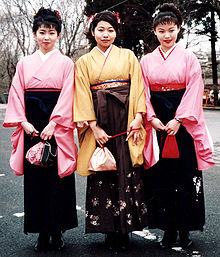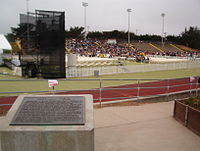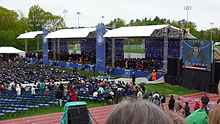- Graduation
-
For other uses, see Graduation (disambiguation).
 Academic procession during the University of Canterbury graduation ceremony.
Academic procession during the University of Canterbury graduation ceremony.
Graduation is the action of receiving or conferring an academic degree or the ceremony that is sometimes associated, where students become Graduates. Before the graduation, candidates are referred to as Graduands. The date of graduation is often called degree day. The graduation itself is also called commencement, convocation or invocation. At the University of Cambridge, the occasion on which most graduands receive their BA degree is known as general admission. After degree completion, graduates can be referred to by their graduating year. In the United States and Canada, it is also used to refer to the advancement from a primary or secondary school level.
When ceremonies are associated, they usually include a procession of the academic staff and candidates. Beginning at the secondary school level in the United States, the candidates will almost always wear academic dress, and increasingly faculty will do the same. At the college and university level, the faculty will usually wear academic dress at the formal ceremonies, as will the trustees and degree candidates. "Graduation" at the college and university level occurs when the presiding officer confers degrees upon candidates, either individually or en masse, even if graduates physically receive their diploma later at a smaller college or departmental ceremony.
Contents
Japan
Elementary and secondary schools
Graduation ceremonies are in March followed by entrance ceremonies in April. This coincides with the Japanese school calendar and the Japanese government fiscal year. Graduation is also related to the changing of the seasons and is often reflected in the ceremony decor and related advertising (i.e. new uniforms, backpacks, school supplies...).
Primary and Secondary school graduations in Japan remain similar throughout the nation. Graduation takes place in a school auditorium, agora, or gymnasium. Red and white striped banners are hung to cover the walls and doors. Three large flags hang on the stage. The flag of Japan, of the city, and of the school. A rented bonsai tree is next to the podium. Chairs are reserved for parents, as well as local officials, and special guests including teachers from previous years. The underclassman bring in their classroom chairs and are seated and the in front of the stage and the area for the graduating class. Elementary school students wear their new Junior High uniforms. Secondary schools wear their current uniforms. Sometimes high school students must buy a graduation uniform.
Underclassmen, parents, and teachers are seated first. The vice principal leads in the local officials and special guests. The teachers all stand and bow to them as they enter. When the graduates enter, they are led by their homeroom teachers. Everyone walks very slow and deliberate. They walk in straight lines and make 90 degree turns if turning is necessary. The students line up next to their chairs and wait for the home room teacher to signal and they all sit at once. The homeroom teacher then joins the rest of the teachers. The head of ceremonies asks everyone to stand and bow towards the Japanese flag. This is coordinated by playing three chords on the piano. 1st-prepare, 2nd-bow, 3rd-return upright.
Singing has a large part in the Japanese schools curriculum and is also a big part of graduation. The first song is Japan's national anthem, followed by the city song and the school song. The latter two are usually printed in the program. This is the last time the graduating class will sing the school song together with the rest of the school. At this point, or after diplomas, the lower class sings to the graduating class, and the graduating class to the lower class. Then everyone sings together. Some of the possible songs are: Tabidachi no hi ni ja:旅立ちの日に, Sayonara, "Until the World is One" by Ya-ya-yah, Sakura ja:さくら (森山直太朗), "Aogeba tōtoshi" and "Hotaru no hikari" (Sung to the tune of Auld Lang Syne).
After singing has finished the principal, wearing a Japanese style tuxedo or black tie goes to the podium. Usually a female teacher wearing a hakama brings out diplomas on a large tray. The homeroom teacher for each class calls out the names of his or her students in gender-split alphabetical order. Recently some schools have discontinued splitting the class by gender. Students stand and say "はい", Japanese for "yes". Large classes may only have their names called. Smaller classes might have each student go to the stage and receive their diploma. They queue up, walking in straight lines, 90 degree turns, at a deliberately slow pace. At some Elementary schools the students give a short speech about what they want to do at Junior High before receiving their diplomas.
The principal reads the diploma out loud once to the first student in each class. The diploma is handed over full size in an open cover (not rolled-up). The principal rotates the diploma to face the student and hands it to them. The student receives the diploma by using their left hand first, and then their right hand before pulling it towards them. The student steps back and exchanges bows with the principal. The student then slowly closes the diploma and folds it under their left hand before turning and walking away. Returning to their seats, students stop and bow to the special guests.
After all the students are seated again the principal makes a speech. The speeches are written vertically from top to bottom, right to left on a fan folded piece of paper. The principal's speech is followed by the head of the PTA. At junior high school an underclassmen may give a speech thanking the graduating students for things like being good senpai. And this is followed by a student speech from the student president. Students may give set group speeches, as if a dialogue between the lower class and upper class. Students take turns yelling out parts of the dialogue sometimes being accompanied by everyone or a few other students in unison. This might happen before, in-between and/or after the songs.
After ceremony students may get a final address by their homeroom teacher. A few moments later, the graduates are free to roam around the school, in and out of the teachers’ office. At Junior High school, students take everything with them on the last day and may do school cheers with the underclassman in front of the school. The school calendar does not end with graduation. The next business day after the ceremony 1st and 2nd year students continue classes until spring break officially starts.
South Africa
At the University of the Witwatersrand (WITS), the graduation ceremonies are formal affairs, which include an academic procession by the faculty staff. The WITS choir is always present, and as a fun twist once the academic procession has left the hall, the song "I Got You (I Feel Good)" by James Brown is played over the loudspeakers.[citation needed]
United Kingdom
In the United Kingdom, unlike the United States, students do not usually 'graduate' from school below university level. They will normally leave secondary school or a sixth form college (if applicable) with specific qualifications, such as General Certificate of Education GCSEs and A-levels, Scottish Qualification Authority Standard Grades and Higher national courses or, less frequently, other certificates such as the International Baccalaureate. However, these are not necessarily presented in a formal ceremony.
Many university graduation ceremonies in the United Kingdom begin with a procession of academics, wearing academic dress. This procession is accompanied by music, and a ceremonial mace is often carried. After this, an official reads out the names of the graduates one by one, organized by class of degree or by subject. When their names are called, the graduates walk across the stage to shake hands with a senior official, often the university's Chancellor or the vice-chancellor. Graduands wear the academic dress of the degree they are receiving. At Oxford, however, they wear the dress of their status before graduating (their previous degree, or undergraduate academic dress), afterwards changing into the dress of the degree they have just received. Serving members of the armed forces may wear their military uniform underneath. Member institutions of the University of Wales hold their graduation ceremonies almost entirely in the Welsh language. Some of the older universities may hold their graduation ceremonies in Latin, even though few students understand this language. The Latin section of the ceremony may include a rendition of an anthem, sometimes called the unofficial anthem of all universities, the De Brevitate Vitae, also known as The Gaudeamus.
University of Cambridge
Main article: University_of_Cambridge#GraduationAt the University of Cambridge, graduands are presented in the Senate House college by college. During the graduation ceremony, officially called a Congregation, graduands are brought forth by the Praelector of their college, who takes them by the right hand, and presents them to the vice-chancellor for the degree they are about to take. After presentation, the graduand is called by name and kneels before the vice-chancellor and proffers their hands to the vice-chancellor, who clasps them and then confers the degree. The graduate then rises, bows, and leaves the Senate House through the Doctor's door into Senate House passage, where they receive their diploma.[1]
Graduates receiving an undergraduate degree wear the academical dress that they were entitled to before graduating: for example, most students becoming Bachelors of Arts wear undergraduate gowns and not BA gowns. Graduates receiving a postgraduate degree (e.g. PhD or Master's) wear the academical dress that they were entitled to before graduating, only if their first degree was also from the University of Cambridge; if their first degree is from another university, they wear the academical dress of the degree that they are about to receive, the BA gown without the strings if they are under 24 years of age, or the MA gown without strings if they are 24 and over.[citation needed]
University of St Andrews
The degree ceremony at the University of St Andrews is conducted through a meeting of the Senatus Academicus in the Younger Hall, and dates back to the early antecedents of the University. The graduation is characterised as similar to many others, commencing with an academic procession (juniores priores/in reverse order of seniority) of the masters, Principal, and Chancellor of the University, during which the graduands and their guests sing The Gaudeamus. Once seated the Prayer is read by the Dean of Divinity/Master of St Mary's College. After this graduands are called forward individually by the Dean of the Faculty within which they are a member (Arts, Divinity, Medicine, and Science). The graduand comes forth to the graduation desk before the Chancellor (or in his absence, the Vice-Chancellor), proffering the hood of the degree they are about to be conferred to the Bedellus, and kneels. The chancellor then says in Latin:
- "Te ad gradum Magistri Artium/Baccalaurei Scientiae/Baccalaurei Sacrosanctae Theologiae/Baccalaurei Scientiae Medicinae promoveo, cuius rei in symbolum super te hoc birretum impono."
("I promote you to the Degree of Master of Arts/Bachelor of Science/Bachelor of Divinity/ Bachelor of Medical Science, as a symbol of which I place this cap upon you.")
The Chancellor then touches the graduand's head with the graduation cap, and the Bedellus steps forth and places the hood of the degree to be conferred over the newly promoted graduate. The graduate then rises and bows to the Chancellor, and exits the stage to collect their diploma, before joining their fellow graduates in the main hall. Once the ceremony is complete the Benediction is read, again by the Dean of Divinity, and the academic procession leaves the hall seniores priores/in order of seniority, with the new graduates joining the end as a sign of the accession to the academic community. The procession continues down North Street to the quadrangle of the United College of St Salvator and St Leonard, where it dissolves.
After each afternoon graduation, the General Council hosts a garden party for the new graduates and their guests, usually on the Lower College Lawn.
The Open University
Due to the large number and geographical dispersion of students, unlike most UK universities, degree ceremonies at the Open University are not the occasion on which degrees are formally conferred. This happens in absentia at a joint meeting of the University's Council and Senate ahead of the ceremony. The University's ceremonies – or "Presentations of Graduates" – occur during the long summer throughout Britain and Ireland, as well as one ceremony in Versailles.[2]
United States of America
In the United States, besides "commencement," the term "graduation" is also used in schools below university level such as the high school, middle school and even kindergarten and preschool ceremonies.
The American Council on Education (ACE) is the authority on academic regalia in the US, and has developed an Academic Ceremony Guide[3] that is generally followed by most institutions of higher learning. The ceremony guide and the related Academic Costume Code provide the core of academic ceremony traditions in the US. The ACE code addresses college and university dress: high school and other lower school gown colors vary from institution to institution.[4]
At many large US institutions, where many hundreds of degrees are being granted at once, the main ceremony (commencement) involving all graduates in a sports stadium, amphitheater, parade ground or lawn, or other large – often outdoor – venue is usually followed, but sometimes preceded, by smaller ceremonies (diploma ceremony) at sites on or around campus where deans and faculty of each academic organization (college, academic department, program, etc.) distribute diplomas to their graduates. Another means of handling very large numbers of graduates is to have several ceremonies, divided by field of study, at a central site over the course of a weekend instead of one single ceremony. At large institutions the great number of family members and guests that each graduating student wishes to attend may exceed the capacity of organizers to accommodate. Universities try to manage this by allocating a specified number of graduation tickets to each student that will be graduating.
It is also common for graduates not to receive their actual diploma at the ceremony but instead a certificate indicating that they participated in the ceremony or a portfolio to hold the diploma in. At the high school level, this allows academic administrators to withhold diplomas from students who are unruly during the ceremony; at the college level, this allows students who need an additional quarter or semester to satisfy their academic requirements to nevertheless participate in the official ceremony with their cohort before receiving their degree. In addition, with large numbers of students receiving diplomas and often no specific order they walk in, it is impossible for their actual diplomas to be given to them at the ceremony, thus them receiving simply a blank diploma to be filled later.
At most colleges and universities in the US, a faculty member or dean will ceremoniously recommend that each class of candidates (often by college but sometimes by program/major) be awarded the proper degree, which is then formally and officially conferred by the president or other institutional official. Typically, this is accomplished by a pair of short set speeches by a senior academic official and a senior institutional official:
- "Mr. President, on behalf of the faculty of Letters and Science, I hereby declare that these candidates have met all the requirements for the degree of ... and request that such degree be conferred upon them." "Under the authority vested in me by the State of (?) and the Trustees of ? College, I hereby confer upon these candidates the degree of ..."
For students receiving an advanced degree, many colleges include a Hooding Ceremony in their commencement program, in which the students wear a hood. Candidates traditionally have the hood placed upon them at the podium, though this has become less practical at large commencement ceremonies. At Fordham University, graduates of a college put on the hood by themselves en masse after the university president confers the degree upon them from the podium. This is called 'to self-hood'. Doctorates are nearly universally hooded upon the stage.
The hood is a part of traditional academic dress whose origins date back many centuries. Today, the hood is considered by some to be the most expressive component of the academic costume. Today’s hoods have evolved from a practical garment to a symbolic one. An academic hood is a symbolic garment, which is worn draped around the neck and over the shoulders, displayed down the back with the lining exposed. The hood’s length signifies the degree level; with the institution's colors in the lining and a velvet trim in a standardized color that signifies the scholar’s field.
Graduation speech
Main article: Commencement speechA graduation or commencement speech, in the U.S., is a public speech given by a student or by alumnus of a university to a graduating class and their guests. Common themes of the graduation speech include wishing the graduates well in the "real world", cautioning that the world of academe is a special place where they were taught to think (a common variation contradicts this view). More recently, the trend has been to find a celebrity or a politician to deliver the speech. Notable exceptions are Columbia University, Davidson College, and Belmont University, where the tradition has been that only the current university president gives the commencement address. Though there is only one commencement, individual colleges and schools of Columbia often invite a speaker at separate graduation ceremonies held earlier or on another day, however.
Special graduation ceremonies
Many homeschooling groups hold their own graduation ceremonies, as it is uncommon (and often not permitted) for homeschool graduates to participate in their local school district's official graduation ceremony. Some GED testing centers hold graduation ceremonies for those who take the GED and pass.
The parents and students of the class of 2009 in Centerburg, Ohio held their own unofficial graduation ceremony at the local park when the school board decided to cancel the official graduation ceremony, in response to a cheating scandal,[5] even though only one person out of the entire 97-student graduating class was ever proven guilty of cheating. The school board's response was criticized by most media outlets in Ohio and even gained nationwide media coverage in the United States. The parents' and students' decision to hold their own graduation ceremony was cheered by many local businesses, and received mixed views, mostly through later letters to the editor of the Columbus Dispatch and other newspapers in the area.
See also
- High school graduation examination
- Academic dress
- Encaenia
- Matriculation
References
- ^ http://www.admin.cam.ac.uk/univ/degrees/ceremony/
- ^ http://www.open.ac.uk/ceremonies
- ^ http://www.acenet.edu/AM/Template.cfm?Section=Search&template=/CM/HTMLDisplay.cfm&ContentID=22417#Ceremony
- ^ http://www.rhymeuniversity.com/Elementary_Middle_High_School_Graduation_Gown_Sets%7Cp113_c48_o0.html
- ^ http://www2.nbc4i.com/news/2009/jun/07/seniors_hold_graduation_after_board_cancels_ceremo-ar-14107/
6.http://www.graduation-gift-ideas.com/Graduation-gift-etiquette.html
7.http://www.mgdezigns.com/Invitation/grad.phpExternal links
- The Stories Behind Graduation Traditions by Ethan Trex, Mental Floss
Categories:- Educational stages
- School terminology
- Ceremonies
- Graduation
Wikimedia Foundation. 2010.





